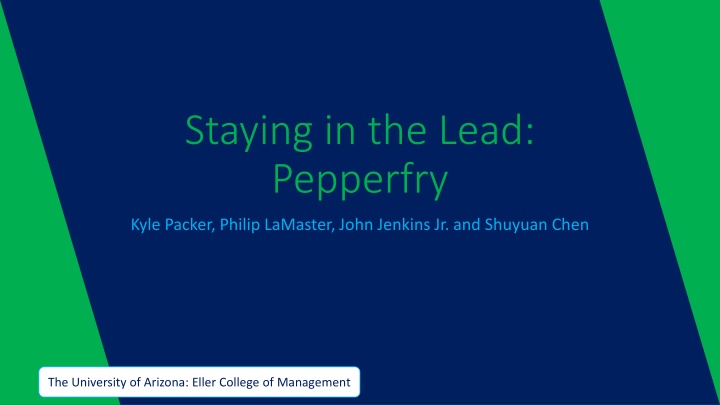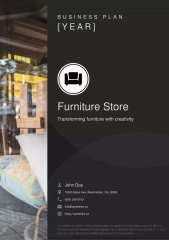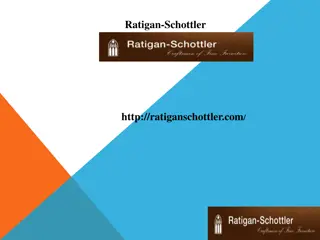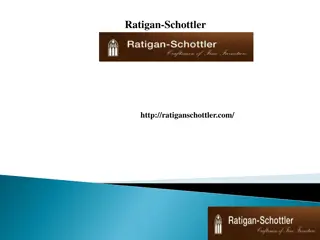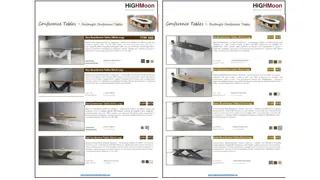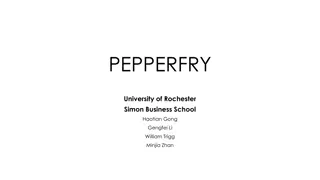Navigating the Furniture Industry: The Story of Pepperfry
Pepperfry, led by a team from The University of Arizona, is aiming to maintain its lead position in the competitive online furniture and home decor sector. The company's strategy involves leveraging consumer intel, curating diverse collections, and controlling market forces to turn growth into gains and become EBITDA positive. Facing challenges from both large competitors with network benefits and smaller competitors with distinctive collections, Pepperfry is focused on building a strong moat by expanding its delivery network and franchise presence across India.
Download Presentation

Please find below an Image/Link to download the presentation.
The content on the website is provided AS IS for your information and personal use only. It may not be sold, licensed, or shared on other websites without obtaining consent from the author.If you encounter any issues during the download, it is possible that the publisher has removed the file from their server.
You are allowed to download the files provided on this website for personal or commercial use, subject to the condition that they are used lawfully. All files are the property of their respective owners.
The content on the website is provided AS IS for your information and personal use only. It may not be sold, licensed, or shared on other websites without obtaining consent from the author.
E N D
Presentation Transcript
Staying in the Lead: Pepperfry Kyle Packer, Philip LaMaster, John Jenkins Jr. and Shuyuan Chen The University of Arizona: Eller College of Management
Agenda Agenda Situation Challenge Recommendation Analysis Implementation Risks Finances Summary 2
The The Pepperfry Pepperfry Model Model More consumers = More value for manufacturers Consumers Manufacturers Pepperfry More products = more variety for consumers 3
The The Pepperfry Pepperfry Model Model Pepperfry provides consumer intel Consumers Manufacturers Pepperfry Pepperfry curates collections 4
The Industry Is At An Inflection Point The Industry Is At An Inflection Point Industry Online retail of furniture and home d cor. Availability of substitutes Pepperfry advantage dependent on size of platform Availability of complements Internal Competition High barriers to entry: Distribution centers, warehouses, contractor networks Buyer Power Supplier Power Pepperfry model controls these forces 5
Pepperfry Pepperfry: Turning growth into gains : Turning growth into gains Become EBITDA positive in 12-18 months Maintain lead position in industry Goal Rising competition in industry pressures Pepperfry Challenge Large Competitors have equal network benefits Small competitors have more distinct collections Complications 6
Competitive Landscape Competitive Landscape Big Box Furniture Big Online Retailer Small Online Pepperfry Buyer Network Supplier Network Customer Experience Delivery network 7
Building a strong moat Building a strong moat Be Everywhere Allow Pepperfry to be delivered anywhere in India Grow Franchisees Grow Delivery Network 8
Be Everywhere Be Everywhere Less than 10% of projected furniture market will be online Only 17 delivery centers and 400 delivery vehicles: to service over 30 million consumers. Only 34 studios, 7 franchise owned. Offline retailers can t reach more extended areas. Online retailers don t have access to majority of market that s offline 9
Grow Franchisees Grow Franchisees Lower set-up costs and inventory for smaller franchises Expand customer layaway plans (from max 12 To 24 mn.) Supplement with operations expertise 10
Grow Our Delivery Network Grow Our Delivery Network Prior, contract delivery suffered quality problems Now, technology allows better validation of quality Contract Delivery Pepperfry Warehouse Distribution Contract Customer At each point package is scanned for damage and uploaded to internal blockchain network to ensure quality 11
Implementation plan Implementation plan 2019 2020 2021 2022 2023 Pilot Non-urban Franchise Stores Develop proprietary POS for all stores and studios. Develop blockchain delivery system Go live with first 100 non- urban franchise Develop initial delivery contractors Go live with initial blockchain validation system Location specific collections Monetize data and other non-urban position Phase 1 Phase 2 Phase 3 12
Risk and Mitigation Risk and Mitigation Risk Probability Impact Mitigation Ease barriers to franchisee entry Slow growth in franchises Medium High Lower than expected profits in non-urban studios Continue supply-chain optimization Medium Medium Implement stricter delivery and logistic quality assurances Poor quality non-urban delivery system High Medium 13
Financial Implications Financial Implications Expansion to rural markets with cost ~200 million INR in 2019-2020 and yield significant profit. Financial Projections for Non-Urban Expansion 5,000 4,500 Assumptions (Million INR) 4,000 3,500 Non urban set up cost Engineer Annual Cost Engineers NU Delivery cost CGS 0.2 3,000 1.04 2,500 20 2,000 15% 50% 1,500 1,000 500 - 2019 2020 2021 2022 2023 revenue of non-urban Gross Margin Total Cost NonUrban Profit Margin 14
Store Growth Projections Store Growth Projections Non Urban Stores are major source of revenue growth 600 500 400 number of Non-urban stores 300 number of urban franchise 200 100 0 2019 2020 2021 2022 2023 15
Summary Summary Be Everywhere Allow Pepperfry to be delivered anywhere in India Grow Franchisees Grow Delivery Network 16
Back Back- -Up: Financial Projections Up: Financial Projections 2019 2020 2021 2022 2023 number of Non-urban stores 50 100 180 324 518 revenue of non-urban 450 900 1,620 2,916 4,666 CGS 225.0 450.0 810.0 1,458.0 2,332.8 Gross Margin 225.0 450.0 810.0 1,458.0 2,332.8 Project costs Franchise Setup Costs 10 10 16 29 39 IT Costs 20.80 20.80 6.24 6.24 6.24 Non IT Costs 68 135 243 437 700 Total Cost 98.30 165.80 265.24 472.44 744.96 NonUrban Profit Margin 127 284 545 986 1,588 17
